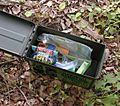Geocaching facts for kids
Geocaching is a fun outdoor game where people use a special device called a GPS to find hidden containers. These containers are called "geocaches" or "caches." Players hide them and then share their locations online for others to find.
One cool thing about geocaching is that caches are often hidden in interesting places. These spots might not be famous tourist attractions, but they often have a unique story or a nice view. The person who hides the cache usually shares some facts about the location.
Today, there are more than 3 million active geocaches hidden all over the world! Over 5 million people enjoy playing this game.
Contents
How Geocaching Started
Geocaching began shortly after May 2, 2000. On that day, the US government stopped adding a small error to GPS signals. Before this, a GPS device might tell you your location was off by about 100 meters (about the length of a football field). After May 2, 2000, GPS became much more accurate, usually within 3 meters (about 10 feet)! This new accuracy made it possible for people to pinpoint exactly where a hidden cache was.
The very first geocache was hidden on May 3, 2000, by a person named Dave Ulmer in Beavercreek. Just three days later, on May 6, 2000, Mike Teague from Vancouver found it. The game was first called GPS Stash Hunt. But after some players talked about it, the name was changed to Geocaching on May 30, 2000.
What is a Geocache?
A geocache is usually a strong, waterproof container, like a plastic box. Inside, you'll always find a logbook. When you find a cache, you write your geocaching nickname and the date you found it in this logbook.
Bigger geocaches might also have small items for trading. These can be little toys, hockey cards, or special items called Travel Bugs or Geocoins. Travel Bugs and Geocoins are unique because they have a special code. You can log them on the geocaching website and move them from one cache to another. They travel all over the world!
The person who hides a cache (the owner) puts its coordinates (its exact location) on the official Geocaching.com website. They also add information about how hard it is to find (difficulty), how tough the area is to walk through (terrain), and the size of the container. After a reviewer checks everything, the cache details are published for other geocachers to find.
Different Kinds of Geocaches
There are many types of geocaches, making the game even more exciting!
Traditional Cache
This is the most common type. You get the exact coordinates, go to that spot, and find the hidden container. It's straightforward and a great way to start.
Multi-Cache
For a multi-cache, you don't go straight to the final container. Instead, you visit several "stages." At each stage, you find a clue, like a number on a sign. You use these clues to figure out the coordinates for the next stage, until you finally find the last stage with the actual geocache.
Mystery or Puzzle Cache
These caches are like riddles! The coordinates for the final cache are hidden in a puzzle, a secret code, an image, or some text. You have to solve the puzzle first to find out where the cache is hidden.
Letterbox Hybrid Cache
This type mixes geocaching with another hobby called letterboxing. Inside the container, instead of just a logbook, you'll find a special stamp. You can use this stamp to mark your own personal diary or logbook.
Webcam Cache
This isn't a physical box. Instead, you go to the published coordinates, where there's a webcam. You then take a picture of yourself using the webcam, and that counts as finding the cache!
Virtual Cache
Like webcam caches, virtual caches don't have a hidden box. You go to the coordinates and find a specific piece of information, like the name on a monument. You then send this information to the cache owner to prove you were there.
EarthCache
EarthCaches are similar to virtual caches but are always at a special geological or geographical spot. You visit the location, learn about the Earth science there, and answer questions about it. You might also take a photo. You send your answers and photo to the cache owner.
Event Cache
An event cache is a gathering where geocachers meet up. It's a chance to share stories, trade trackable items, and meet other players. A special type of event is called CITO, which stands for "Cache In, Trash Out." At CITO events, geocachers work together to clean up an area. If more than 500 people attend an event, it's called a Mega-event. If over 5,000 people attend, it's a Giga-event!
Images for kids
-
A Geocacher finding a Virtual Cache at McMurdo Station, Antarctica.
-
A 79-year-old man fell off a cliff in Dishman Hills, Washington, while geocaching in 2009.
See also
 In Spanish: Geocaching para niños
In Spanish: Geocaching para niños











